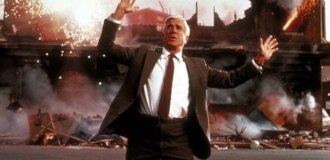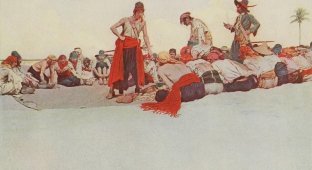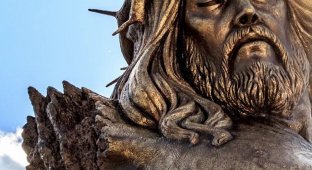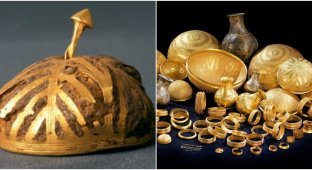The flagship of the Golden Age of Piracy. How did a bottle of rum kill Edward Teach? (8 photos)
Piracy is an integral part of popular culture, and everyone is familiar with pirate paraphernalia such as an eye patch, a wooden leg, and various other clichés. The origins of the modern pirate image, which, in fact, does not have much in common with reality, go back to the so-called “Golden Age of Piracy,” that is, at the end of the 17th and beginning of the 18th centuries. 
The book “A General History of the Robberies and Murders of the Most Notorious Pirates,” by Captain Charles Johnson (pseudonym, real name of the author unknown).
It is assumed that he may be the writer Daniel Defoe
Edward Teach, being one of the most famous robbers of this era, firmly went down in history under the nickname “Blackbeard”. The cultural imprint he left behind is closely linked to his flagship, Queen Anne's Revenge, which is also shrouded in legends and tales of treasure.
early years
It’s worth saying right away that there is no information about Tich’s early years of life: the captain did not leave any memoirs. However, the biography of many famous sea robbers is fraught with a lot of mystery. Take the same Henry Avery, about whose last years there is absolutely no reliable information.
Modern people know about the life of Blackbeard largely thanks to the book from 1724, “A General History of the Robberies and Murders Committed by the Most Famous Pirates,” written by an author whose real name is unknown. Some details of Teach’s biography coincide with archival documents, therefore most of the facts from his biography are considered true.
The real name of one of the most famous English pirates, who went down in history as Edward Teach, is unknown. Sea robbers often used pseudonyms so as not to tarnish their name. It is likely that Blackbeard’s name was really Edward, and Teach (from the English teach - “to teach, to train”) was his first pseudonym, the origin of which also raises questions.
According to an alternative version, his first nickname is Edward Thatch (English thatch - thick hair), which, of course, is a reference to his long and thick beard. Although in literature and cinema the robber is still known as Edward Teach. 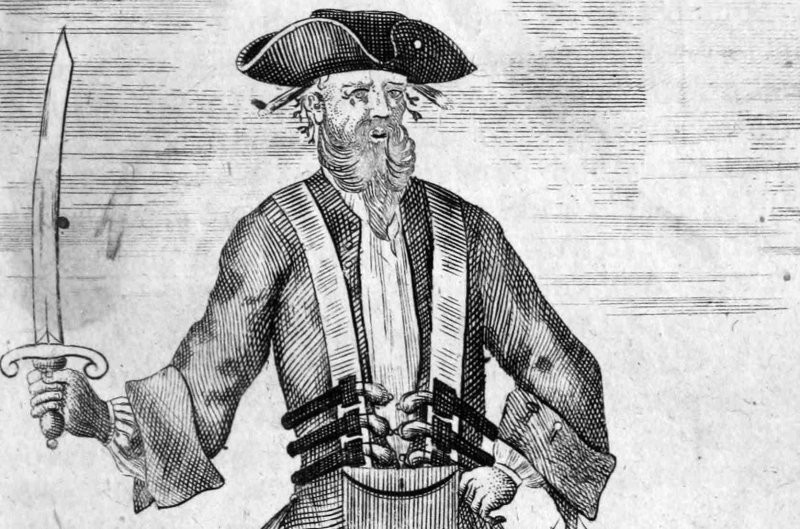
Antique engraving of Blackbeard
It is generally accepted that at the time of his death in 1718, Blackbeard was no more than 40 years old. Thus, the future pirate was born in England around the 1680s, presumably into a wealthy family, since he could read and write.
Referring to the General History of Plunder..., Edward Teach arrived in the Caribbean at the end of the 17th century, beginning service on privateering ships that operated on the side of the British crown during the War of the Spanish Succession. Part of this war was
local conflict in North Africa, later called Queen Anne's War.
Republic of Pirates
After the signing of the peace treaty, most of the privateers, left without work, continued attacks and robbery, but their target was any ships. Finding themselves outlawed, the robbers settled in the Bahamas, where they created their own state. Perhaps it was the republic of pirates that served as the prototype for the fictional pirate utopia of Libertalia, which was described in the same “General History of Robbery...”.
The “state” of the corsairs was independent and uncontrollable by the British Empire, and therefore became a stronghold for pirates from all over the world. It is not surprising that Edward Teach and his colleagues moved to the Bahamas. One of the most authoritative and famous pirates of that time was Benjamin Hornigold, who may have become Teach's mentor. However, it is difficult to judge the presence of subordination in their relationships. All we can say with certainty is that Teach received a sloop from Hornigold and sailed with him for some time. 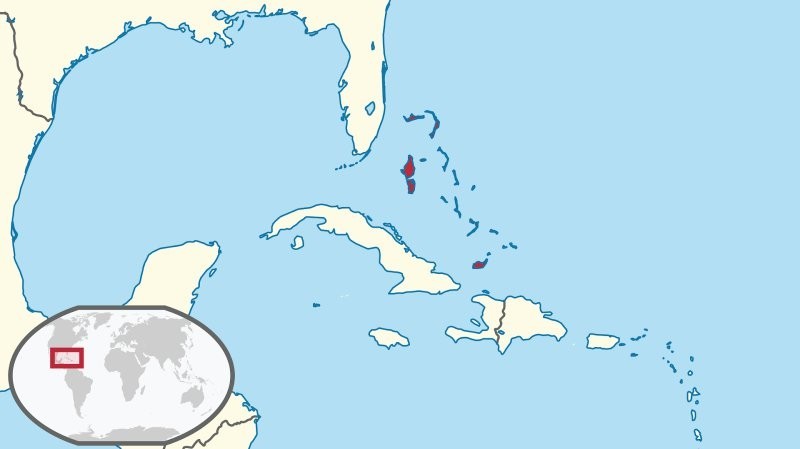
Location of the Bahamas, where the Pirates' Republic was formed (dissolved in 1718)
A year later, Edward Teach had two ships at his disposal - the Revenge and his first nameless sloop. In the fall of 1717, Hornigold moved away from piracy, and later became a hunter of sea robbers. He was tasked with capturing former colleagues in a dangerous profession, including Blackbeard. Looking ahead, it is worth noting that Hornigold did not become a successful hunter, and he died during a hurricane in 1719.
Teach and his "Queen Anne's Revenge"
In November 1717, the Revenge and Blackbeard's sloop met the French merchant ship Concorde, which was built in Bristol, Teach's supposed hometown.
Surprisingly, Teach only needed a few cannon shots to capture the 200-ton ship. Having received a new ship at his disposal, Blackbeard showed amazing generosity: he released the entire crew and the slaves being transported. They were landed on the island, and Teach provided a sloop for those who wished to join.
The Concorde underwent modernization: the pirates equipped the ship with heavy cannons, increasing their number from 14 to 40. Raising a black flag with a skull, Blackbeard gave his flagship a new name - Queen Anne's Revenge. 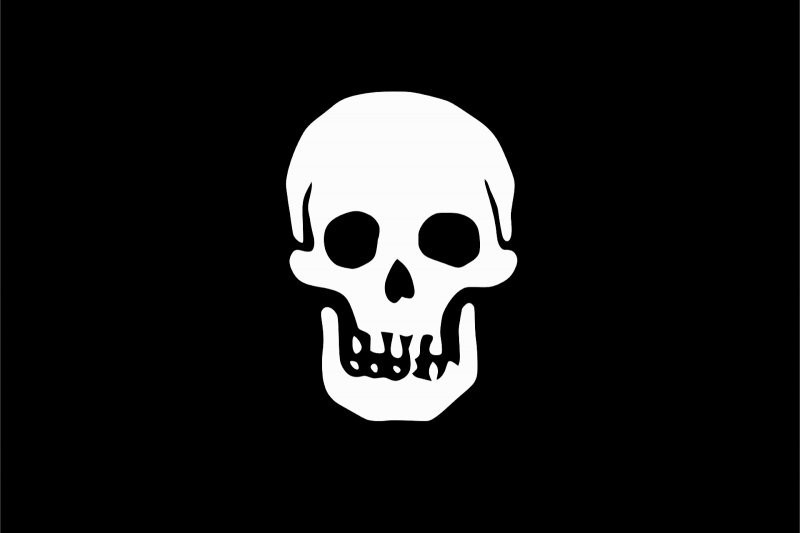
The supposed flag of Captain Teach is a black canvas with a skull, one of the symbols of death in Christianity. An alternative flag is a blood-red canvas without symbols
The reason why Teach named his flagship this way is unknown. But it is likely that “Queen Anne’s Revenge” is a reference to the aforementioned Queen Anne’s War, which, however, ended in victory for England. So it is not entirely clear what kind of revenge we are talking about.
Age of robbery
The first ship to fall under the onslaught of the Revenge was the Great Allen, a large merchant ship sailing near the island of St. Vincent in the Antilles archipelago. Having landed the crew, the thugs devastated and then burned the ship to the ground.
A few days later, the small sloop Margaret became the prey of the pirates. The captain of the ship, who was captured by Teach, was released unharmed along with his crew. This man was the first to describe Blackbeard's appearance.
Teach had a “very black and long beard,” which he wore in braids. He perfectly understood the meaning of the terrifying image, the addition of which were three pistols hanging on a sling over his shoulder and a long cloak. A wide-brimmed hat was an attribute of many pirates, including Blackbeard, which is repeatedly reflected in popular culture.
However, despite his terrifying appearance, Edward Teach himself never killed or harmed his captives. At least, apart from robbery and robbery, there is no reliable information about such atrocities of his. 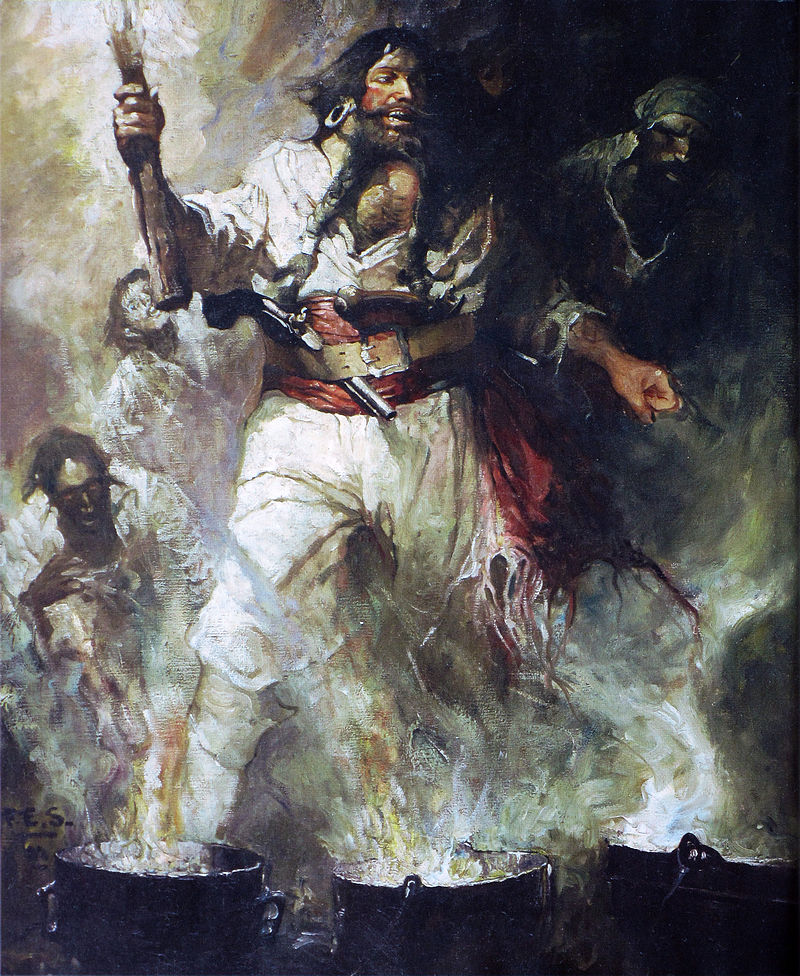
The image of Edward Teach in the painting “Blackbeard in Smoke and Fire” by artist Frank Schoonover
For several months, Queen Anne's Revenge terrorized the sea, and attempts to catch Blackbeard were unsuccessful. Already in March 1718, the famous corsair had at his disposal three relatively large ships and five sloops. In May, Teach's pirate flotilla blockaded Charles Town in South Carolina. Having captured nine ships, the robbers captured wealthy citizens of the city.
The pirate crew was in dire need of medicine, and Blackbeard demanded it, threatening to send the head of each captive personally to the governor, and also to burn all the ships in the port. Since the seizure of each vessel was demonstrative, such a statement brought a lot of fear to already worried citizens.
Despite the fact that the governor agreed to fulfill the pirates' demands, they received the medicine only a few days later. First, the boat with the envoy and his guard capsized. Then two pirates from the escort disappeared: they were simply drinking. Ultimately, the robbers' loot was a couple of thousand pounds and medicines - not so much compared to the successes of other famous robbers. 
Model of Queen Anne's Revenge at the North Carolina Museum of History
The captain, much to the surprise of the citizens, released the prisoners and freed the captured ships, after which he set off for North Carolina. Here Queen Anne's Revenge ran aground so badly that the mainmast broke off and the hull cracked. One of the sloops also ran aground. The story of Blackbeard's flagship has come to an end. There is an opinion that this was done on purpose in order to reduce the size of the team, thereby increasing the share in the production. In addition, a hunt began for the pirate, and the large frigate became a burden.
At this moment, several dozen sailors from Teach’s team rebelled. The rebellion was suppressed, and the most active rebels were abandoned with only one bottle of rum on the small island of Dead Man's Chest, located near Peter Island. And the rum was left to the abandoned sailors, clearly not out of pity. After all, as you know, strong alcohol does not quench, but only increases thirst. This story of dubious authenticity is reflected in the song "Yo-ho-ho and a Bottle of Rum."
The last boarding
The appearance of Blackbeard and another pirate, Charles Vane, in North Carolina worried the governor of neighboring Virginia. He despised the Carolinians and did not rely on their assistance in finding the criminals. Therefore, I decided to take everything into my own hands.
The ex-quartermaster of the former flagship Teach settled in one of the Virginia cities, and after his arrest he spoke about the whereabouts of the captain. Two poorly armed sloops under the command of Lieutenant Robert Maynard set off for Blackbeard.
On November 21, 1718, Maynard approached Ocracoke Sound. This place with an excellent view was the favorite stop of Edward Teach. After the incident with the flagship, the pirate’s crew numbered no more than 30 people, most of whom were on shore at the time of discovery by the lieutenant. The captain himself indulged in drunkenness and did not expect a raid.
Maynard, who wanted to trap the storm of the Caribbean Sea, hid most of the crew inside the ship and began to close the distance. The pirates, having discovered the enemy, began firing from their guns. And, I must say, very effectively: after just a few minutes, Maynard lost a third of the team. 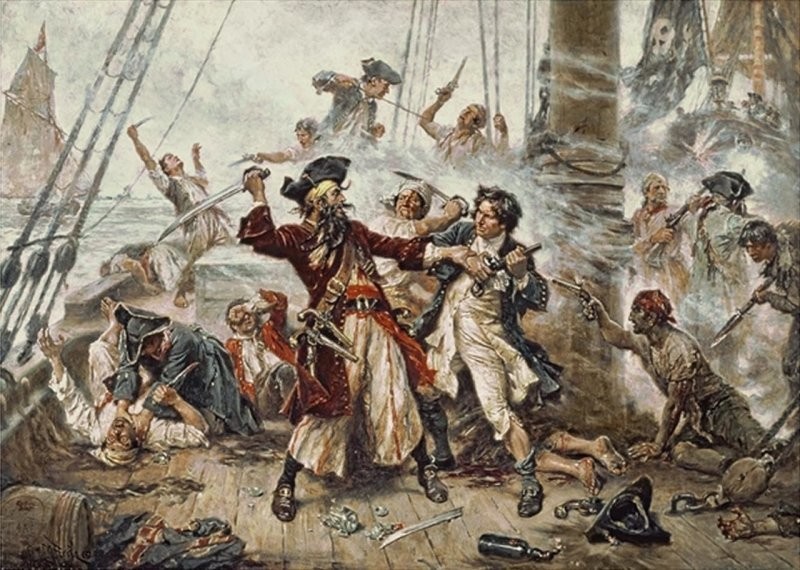
Painting by the famous American artist Jean Leon Jerome Ferris “The Capture of the Pirate Blackbeard.” A short duel between Teach and Maynard
Leaving the bottle, Edward Teach quickly assembled a boarding team and set out on a sloop to the scene of events. Approaching the damaged English ships, the captain led the team to board, but he was met by the hidden British. As a result, the thugs were pushed to the bow of the ship and surrounded.
During the duel with Maynard, Blackbeard was seriously wounded in the neck, after which he was finished off by the enemy team. In total, Captain Teach received over twenty wounds, of which five were bullet wounds. He was beheaded and his head hung on the forward mast as proof of the corsair's death. Most of the surviving pirates were executed.
In just the six months that Teach was the commander of the ship Queen Anne's Revenge, he became known as one of the most dangerous robbers in the Caribbean. And although Blackbeard was not the most successful pirate of his time, his image of a ruthless corsair became one of the most recognizable in popular culture.
And almost 300 years later, in 2012, a group of archaeologists discovered Queen Anne's Revenge. The 18-meter vessel was buried under a meter of silt. Work to raise Blackbeard's flagship from the bottom was stopped due to litigation. Currently, research is being carried out on various artifacts found on the ship. Unfortunately or fortunately, we are not talking about any untold riches.
